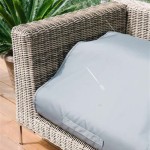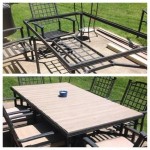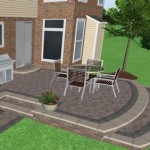Temporary Patio Flooring Over Grass: A Comprehensive Guide
Creating a temporary patio over grass offers a practical solution for various needs, ranging from hosting events to enhancing outdoor living spaces without the permanence of traditional construction. This approach allows homeowners and renters to enjoy a functional patio area that can be easily installed and removed, leaving the underlying grass relatively undisturbed. Understanding the available options, installation methods, and maintenance requirements is crucial for achieving a successful and satisfying outcome.
The selection of temporary patio flooring materials depends on factors such as budget, desired aesthetic, intended use, and the expected duration of the patio's presence. Common materials include interlocking deck tiles, rubber mats, outdoor rugs, and even gravel contained within a frame. Each option presents unique advantages and disadvantages, influencing the overall suitability for a specific application.
Proper site preparation is essential for ensuring the stability and longevity of the temporary patio. This involves leveling the ground, addressing drainage concerns, and potentially incorporating a protective layer to minimize damage to the underlying grass. Neglecting these preparatory steps can lead to an uneven surface, water accumulation, and increased risk of grass deterioration.
Choosing the Right Temporary Patio Flooring Material
The market offers a diverse range of materials suitable for temporary patio flooring installations. Each material possesses distinct characteristics that impact its performance, appearance, and ease of installation. Evaluating these factors is critical for making an informed decision that aligns with specific needs and preferences.
Interlocking deck tiles are a popular choice due to their ease of installation and durability. These tiles typically consist of plastic, wood composite, or even natural wood, offering a variety of aesthetic options. Installation involves simply snapping the tiles together, creating a seamless and stable surface. The raised design of many interlocking tiles allows for air circulation, reducing the risk of moisture buildup and grass rot. However, the initial cost of interlocking deck tiles can be higher compared to some other options.
Rubber mats provide a cost-effective and versatile solution for temporary patio flooring. These mats are typically made from recycled rubber, offering excellent durability and shock absorption. Rubber mats are particularly well-suited for areas that require a non-slip surface, such as around swimming pools or play areas. Installation is straightforward, involving simply laying the mats over the prepared surface. However, rubber mats may not offer the same aesthetic appeal as some other options, and they can retain heat in direct sunlight.
Outdoor rugs offer a softer and more aesthetically pleasing option for temporary patio flooring. These rugs are typically made from synthetic fibers that are resistant to water and fading. Outdoor rugs can transform a bare lawn into a comfortable and inviting outdoor living space. Installation is simple, involving unrolling the rug over the prepared surface. However, outdoor rugs require regular cleaning to prevent the buildup of dirt and debris, and they may not be as durable as some other options.
Gravel, when contained within a frame, can provide a rustic and natural-looking temporary patio surface. This option involves constructing a frame from wood or other materials and filling it with gravel. The frame helps to contain the gravel and prevent it from spreading into the surrounding lawn. Gravel provides good drainage and can be relatively inexpensive. However, gravel can be uncomfortable to walk on barefoot, and it may require occasional raking to maintain a level surface.
Preparing the Grass Area for Flooring Installation
Proper site preparation is crucial for ensuring the stability and longevity of the temporary patio, as well as minimizing damage to the underlying grass. This involves carefully addressing leveling, drainage, and protection to create a suitable foundation for the chosen flooring material.
Leveling the ground is essential for creating a stable and even surface. Uneven ground can lead to instability in the patio flooring, potentially causing tripping hazards and premature wear and tear. Using a level and a shovel, carefully remove any high spots and fill in any low spots until the surface is as level as possible. For larger areas, a sod cutter can be used to remove the grass and topsoil, allowing for more extensive leveling before replacing the sod or adding new topsoil.
Addressing drainage concerns is critical for preventing water accumulation and grass rot. Standing water can damage both the patio flooring and the underlying grass, leading to mold growth and unpleasant odors. Ensure that the area has adequate drainage by creating a slight slope away from the house or other structures. Alternatively, consider installing a drainage system, such as a French drain, to redirect water away from the patio area.
Protecting the grass is important for minimizing damage and ensuring that it can recover quickly after the temporary patio is removed. Consider laying down a layer of landscaping fabric or perforated plastic sheeting before installing the patio flooring. These materials allow for air circulation and drainage while providing a barrier between the patio flooring and the grass. Avoid using solid plastic sheeting, as this can trap moisture and lead to grass rot.
Consider the long-term health of the grass. Prolonged coverage can lead to discoloration and weakening. Rotating the patio's location periodically, if feasible, can allow different areas of the lawn to recover and regain their health. Supplementing with fertilizer and regular watering in the uncovered areas can also promote overall lawn health.
Installation and Maintenance of Temporary Patio Flooring
The installation process varies depending on the chosen flooring material. Following the manufacturer's instructions carefully is crucial for achieving a successful installation and ensuring the longevity of the patio.
For interlocking deck tiles, the installation process is typically straightforward. Begin by laying the first tile in a corner of the prepared area. Align the next tile with the first and snap them together. Continue this process until the entire area is covered. Use a rubber mallet to gently tap the tiles together for a secure fit. If necessary, use a saw to cut the tiles to fit around obstacles or at the edges of the patio.
For rubber mats, installation is even simpler. Simply lay the mats over the prepared area, ensuring that they are aligned properly. If necessary, use a utility knife to cut the mats to fit around obstacles or at the edges of the patio. Consider using double-sided tape to secure the mats to the ground and prevent them from shifting.
For outdoor rugs, the installation process involves unrolling the rug over the prepared area. Secure the edges of the rug with stakes or weights to prevent it from blowing away in the wind. Regularly clean the rug to remove dirt and debris. Consider using a rug pad underneath the rug to provide additional cushioning and protect the underlying grass.
For gravel patios, fill the prepared frame with gravel, spreading it evenly throughout. Use a rake to level the gravel surface. Periodically rake the gravel to maintain a level surface and remove any debris. Ensure the frame remains structurally sound to prevent gravel from escaping. Weeding around the edges of the frame may be necessary to maintain a neat appearance.
Maintenance is essential for keeping the temporary patio in good condition and prolonging its lifespan. Regularly sweep or vacuum the patio to remove dirt and debris. Clean spills immediately to prevent staining. Inspect the patio flooring regularly for any signs of damage and repair as needed. Periodically lift the patio flooring to allow the grass to breathe and recover. Consider using a lawn aerator to improve air circulation and drainage. Water the grass regularly to keep it healthy and prevent it from drying out. Removing the patio during the off-season, such as winter, can help the grass recover completely and prepare it for the next growing season. Store the patio flooring in a dry and protected location to prevent damage from the elements.
By carefully considering the available options, preparing the site properly, and following these installation and maintenance guidelines, individuals can create a temporary patio over grass that is both functional and aesthetically pleasing, while minimizing the impact on the underlying lawn.

Outdoor Flooring Over Grass Or Dirt Interlocking Tiles

Rubber Foam Artificial Turf Deck Tiles Buyers Guide Installation

Outdoor Flooring Over Grass Or Dirt Interlocking Tiles

Interlocking Patio Tiles Over Grass 7 Facts You Must Know Cheap Floor Ideas Easy

Outdoor Flooring Over Grass Or Dirt Interlocking Tiles

Outdoor Patio Tiles Interlocking Plastic Rubber Carpet

Outdoor Flooring Options For Style And Comfort 10 Ideas 2024

Hard Flooring For Marquees Pathways To Your Marquee

How To Install Staylock Tiles Over Grass For A Temporary Walkway Youtube

Portable Outdoor Floor Tile Temporary Tent Or Event Flooring








